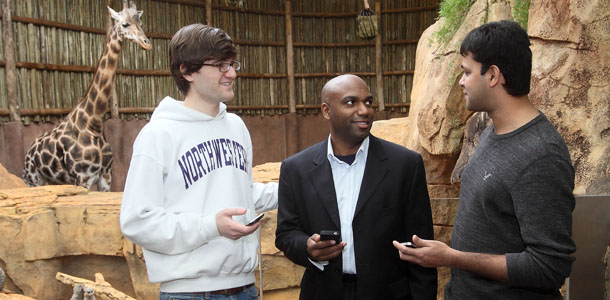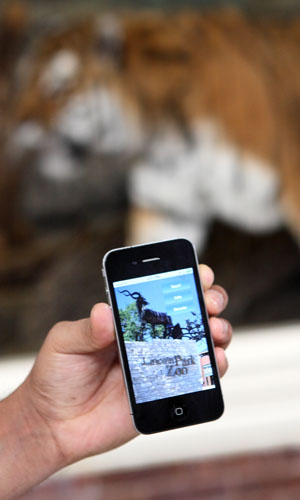Students Partner with Lincoln Park Zoo to Create Mobile App

There are the lions. The giraffes. The seals: More than 1,200 animals on 35 acres at the Lincoln Park Zoo in Chicago. Where do you start? What shouldn’t you miss? When are they eating? Where can you eat? As the saying goes: There’s an app for that.
A recently developed Lincoln Park Zoo application provides maps, photos, schedules and animal information for curious zoo visitors. It’s the result of a multidisciplinary project that allowed Northwestern students to apply what they’ve learned about computer science, management, and marketing, create a real business, and work with one of Chicago’s oldest nonprofit institutions.
The project started in a spring 2010 NUvention: Web course, where students design, build, and run software-based businesses in multidisciplinary teams. A mix of graduate and undergraduate students from the McCormick School, the Kellogg School of Management, and the Weinberg College of Arts and Sciences set out to design an application for a specialty rugged outdoors cell phone. But the team members soon realized they wanted to create an application for a wider audience, though they liked to idea of an app for an outdoor venue. “Many places that don’t have official tours could benefit from the dynamic tour you create in a mobile app,” says Kelsey Recht (Kellogg ’10).
As a dry run, the team mocked up a tour of Northwestern’s campus, complete with audio streaming, photos, and information. The initial feedback to the NU tour app from the course’s advisory board was positive, so the team began researching markets. They considered outdoor venues that would benefit from a map and where traditional museum tour headsets couldn’t be used. The team connected with David Nichols, (McCormick '91; Kellogg '00) a member of the McCormick Advisory Council and the Lincoln Park Zoo board, who had been advocating for more social media at the zoo. “Because the zoo is free, we don’t have a large revenue stream to create a program like this ourselves,” Nichols says. “But the zoo is one of the few attractions in Chicago that has live exhibits, so it’s suited to a mobile application.”
The team formed a company called Enthusiast Apps that would offer clients like the zoo yearly paid subscriptions for specialized mobile tour apps. In addition to the tour, clients receive reports showing where visitors go and how long they spend at the zoo.
Matthew Gilk (computer science, ’12) was charged with creating the application for the iPhone. There was only one problem: he’d never created an iPhone app before. “I was completely ignorant as to how you set up a system like this,” he says. “The difficulty is the organization of data and how you grab that data from our servers. But just like in the real world, you have deadlines that you need to meet. You have to get something on the market.”
 Gilk became deft at searching online forums and technical guides for help, and by the end of the course he had thrown together an app. “It was buggy, and it was pretty ugly, but it worked,” he says. As the zoo reviewed his work and began to ask for more features, it became clear that Gilk would have to take the summer to rebuild the app entirely. He had a full-time job, but spent his nights and weekends coding. “At this point I had put so much work into it that I really wanted to succeed,” he says. “But it was the worst summer of my life. I was pulling all-nighters. Ultimately I reached a new plateau of understanding how apps work, and I’m really grateful for the experience.”
Gilk became deft at searching online forums and technical guides for help, and by the end of the course he had thrown together an app. “It was buggy, and it was pretty ugly, but it worked,” he says. As the zoo reviewed his work and began to ask for more features, it became clear that Gilk would have to take the summer to rebuild the app entirely. He had a full-time job, but spent his nights and weekends coding. “At this point I had put so much work into it that I really wanted to succeed,” he says. “But it was the worst summer of my life. I was pulling all-nighters. Ultimately I reached a new plateau of understanding how apps work, and I’m really grateful for the experience.”
The group created a test app for Zoo Lights, the zoo’s holiday lights festival. That, too, was tense for Gilk — the initial app he sent to the iPhone store was rejected. A few minor adjustments and a personal plea got it online in time for the show, and ultimately, hundreds of users downloaded the app.
The rest of the winter the team focused on fine-tuning the app. It currently has more than 150 destinations on a map of the zoo, complete with video, audio, and photos. For example, if you walk by the lions’ den, information on the animals will automatically pop up on your phone. The app will provide information on scheduled feedings and will ultimately include real-time updates about what animals are up to.
“It has been very engaging,” says Marybeth Johnson, vice president of communication and public affairs for the zoo. “Hopefully it will enhance the visitor experience at the zoo.”
The team hopes to officially launch the application in April — look for it under LPZoo in the iTunes store.
“It has been a true collaboration,” Nichols says. “It’s going to provide a fantastic experience for people that come to the zoo, and it’s given these students an opportunity to create a business. I’m proud of what these students have done. It’s truly a professional, top-notch application.”
Enthusiast Apps hopes to use their experience with the zoo to attract more clients. None of this would have been possible without NUvention: Web, they say.
“In many ways the course simulates how the actual work environment might be at a startup,” Recht says. “You have technology people who are phenomenal coders, and you have business people who know nothing about technology but have a business and marketing background. That sort of collaboration is a valuable experience for everybody.”
- Emily Ayshford